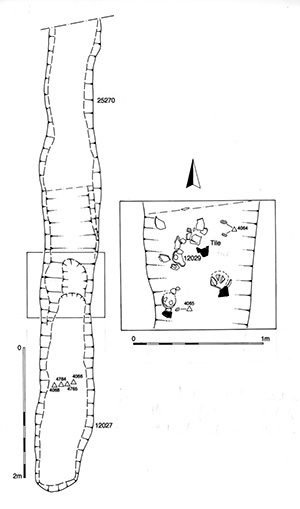
Signs of Late Roman activity along the north bank of the watercourse (i.e. in Excavation Area R) are sparse and shed no light on the nature of the Northern hinterland during this period. This paucity of features may merely be a function of this marginal location. Just to the north and north-west, the Crescent Road excavations contain a greater quantity of Late Roman remains, including a substantial, 5m-wide boundary ditch that runs parallel to the watercourse (Roy 2003) and may mark the southern edge of an enclosed landscape laid across the higher ground.
The north bank of the river channel is occupied by a small cluster of Late Roman post-holes (12011, 12013, 12015, 12017, 12032) and a single isolated post-hole (12013) lying just to the west of ditch 12027 (Group 968 Period 4). The ditch is almost certainly out of use by this point. All are the latest features in the recorded sequence, but none show any patterning.

The Period 4 wood-lined ditch (Figure 175), previously conjectured to be a water channel, drain or even leat , is clearly maintained well into Period 5. Material does not accumulate within the feature until at least the 4th century. The presence of early Saxon pottery relatively low down in the infill sequence may indicate that this did not take place until the 5th century and that the Late Roman material is in fact residual.
Internet Archaeology is an open access journal based in the Department of Archaeology, University of York. Except where otherwise noted, content from this work may be used under the terms of the Creative Commons Attribution 3.0 (CC BY) Unported licence, which permits unrestricted use, distribution, and reproduction in any medium, provided that attribution to the author(s), the title of the work, the Internet Archaeology journal and the relevant URL/DOI are given.
Terms and Conditions | Legal Statements | Privacy Policy | Cookies Policy | Citing Internet Archaeology
Internet Archaeology content is preserved for the long term with the Archaeology Data Service. Help sustain and support open access publication by donating to our Open Access Archaeology Fund.